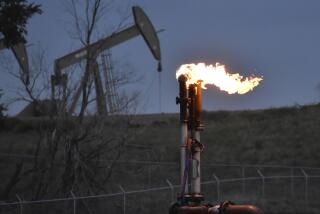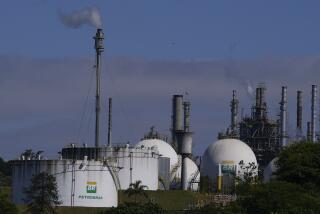Methane in the atmosphere is surging, and that’s got scientists worried
- Share via
Scientists love a good mystery. But it’s more fun when the future of humanity isn’t at stake.
This enigma involves methane, a potent greenhouse gas. Twenty years ago the level of methane in the atmosphere stopped increasing, giving humanity a bit of a break when it came to slowing climate change. But the concentration started rising again in 2007 — and it’s been picking up the pace over the last four years, according to new research.
Scientists haven’t figured out the cause, but they say one thing is clear: This surge could imperil the Paris climate accord. That’s because many scenarios for meeting its goal of keeping global warming “well below 2 degrees Celsius” assumed that methane would be falling by now, buying time to tackle the long-term challenge of reducing carbon dioxide emissions.
“I don’t want to run around and cry wolf all the time, but it is something that is very, very worrying,” said Euan Nisbet, an Earth scientist at Royal Holloway, University of London, and lead author of a recent study reporting that the growth of atmospheric methane is accelerating.
Methane is produced when dead stuff breaks down without much oxygen around. In nature, it seeps out of waterlogged wetlands, peat bogs and sediments. Forest fires produce some too.
These days, however, human activities churn out about half of all methane emissions. Leaks from fossil fuel operations are a big source, as is agriculture — particularly raising cattle, which produce methane in their guts. Even the heaps of waste that rot in landfills produce the gas.

The atmosphere contains far less methane than carbon dioxide, which is the primary driver of climate change. But methane is so good at trapping heat that one ton of the gas causes 32 times as much warming as one ton of CO2 over the course of a century.
Molecule for molecule, methane ”packs a bigger punch,” said Debra Wunch, an atmospheric physicist at the University of Toronto.
For 10,000 years, the concentration of methane in Earth’s atmosphere hovered below 750 parts per billion, or ppb. It began rising in the 19th century and continued to climb until the mid-1990s. Along the way, it caused up to one-third of the warming the planet has experienced since the onset of the Industrial Revolution.
Scientists thought that methane levels might have reached a new equilibrium when they plateaued around 1,775 ppb, and that efforts to cut emissions could soon reverse the historical trend.
“The hope was that methane would be starting on its trajectory downwards now,” said Matt Rigby, an atmospheric scientist at the University of Bristol in England. “But we’ve seen quite the opposite: It’s been growing steadily for over a decade.”
That growth accelerated in 2014, pushing methane levels up beyond 1,850 ppb. Experts have no idea why.
“It’s just such a confusing picture,” Rigby said. “Everyone’s puzzled. We’re just puzzled.”
Scientists have come up with various explanations. Could it be growing emissions from fossil fuels or agriculture? An uptick in methane production in wetlands? Changes in the rate at which methane reacts with other chemicals in the atmosphere?
Nisbet and his team examined whether any of these hypotheses synced up with the changing chemical signature of methane in the atmosphere.
Some molecules of methane weigh more than others, because some atoms of carbon and hydrogen are heavier than others. And lately, the average weight of methane in the atmosphere has been getting lighter.
That seems to implicate biological sources such as wetlands and livestock, which tend to produce light methane. Daniel Jacob, an atmospheric chemist at Harvard who was not involved in Nisbet’s study, said that explanation squares with his own research. His results suggest most of the additional methane comes from the tropics, which are home to vast wetlands and a large proportion of the world’s cattle.
Estimates of emissions from coal mines and oil and gas wells suggest that fossil fuel contributions are rising too, but those sources usually release heavier molecules of methane, which would seem to conflict with the atmospheric observations.
Some researchers have proposed a way to resolve this discrepancy. Fires create an even heavier version of methane, and agricultural burning — particularly in developing countries — appears to have decreased over the last decade. A drop in this source of ultra-heavy methane would make atmospheric methane lighter on the whole, potentially masking an increase in emissions from fossil fuels.
Finally, reactions that break down methane eliminate more of the lighter molecules than the heavier ones. If that process has slowed down — causing methane to build up in the atmosphere — it would leave more light gas behind, possibly helping explain the overall trend.
Nisbet and his colleagues concluded they can’t rule out any of these explanations yet. “They might all be happening,” he said.
One possibility is conspicuously missing from the list. Scientists have long feared that thawing Arctic sediments and soils could release huge amounts of methane, but so far there’s no evidence of that, said Ed Dlugokencky, an atmospheric chemist at the National Oceanic and Atmospheric Administration who worked on the study, which will be published in the journal Global Biogeochemical Cycles.
Nisbet said he fears the rising methane levels could be a sign of a dangerous cycle: Climate change may cause wetlands to expand and allow the environment to support more livestock, leading to even more methane emissions.
“It clearly seems as if the warming is feeding the warming,” he said. “It’s almost as if the planet changed gears.”
If methane keeps increasing, the researchers say, it could seriously endanger efforts to keep the planet’s temperature in check. Slashing CO2 emissions enough to meet climate targets is a tall order even without this extra methane.
“The unexpected and sustained current rise in methane may so greatly overwhelm all progress from other reduction efforts that the Paris Agreement will fail,” Nisbet and his coauthors wrote.
It doesn’t help that scientists recently revised the global warming potential of methane upward by 14%.
Regardless of what’s behind the recent increase, scientists say there are ways to reduce methane concentrations. And the benefits will accrue quickly because methane has a shorter lifetime than CO2, lingering in the atmosphere for only about a decade.
Humans account for as much as 60% of methane emissions, and nearly half of that may come from the fossil fuel industry, Jacob said.
One priority is to plug leaks from oil and gas wells, he said. Methane is the primary ingredient in natural gas, so companies have a financial incentive to try to capture as much as possible.
Often, a few culprits bear most of the blame, “which is both scary and a good thing,” because they represent big opportunities, Wunch said. At the Barnett Shale in Texas, 2% of the facilities produce half of the field’s methane emissions. In Southern California, the Aliso Canyon leak released roughly 100,000 tons of methane in 2015 and 2016 — the equivalent of burning 1 billion gallons of gasoline.
Scientists also have ideas for reducing methane emissions from livestock. Some experiments show that changing the diet of cattle by adding fats or seaweed, for instance, can reduce the amount of methane animals expel. Capping landfills and using the methane they produce for electricity would help too.
Measures like these could have a big impact, and Wunch said they give her reason to be hopeful.
“We could actually reduce the amount of methane in the atmosphere on timescales that are relevant to the problem we are facing right now,” she said.







